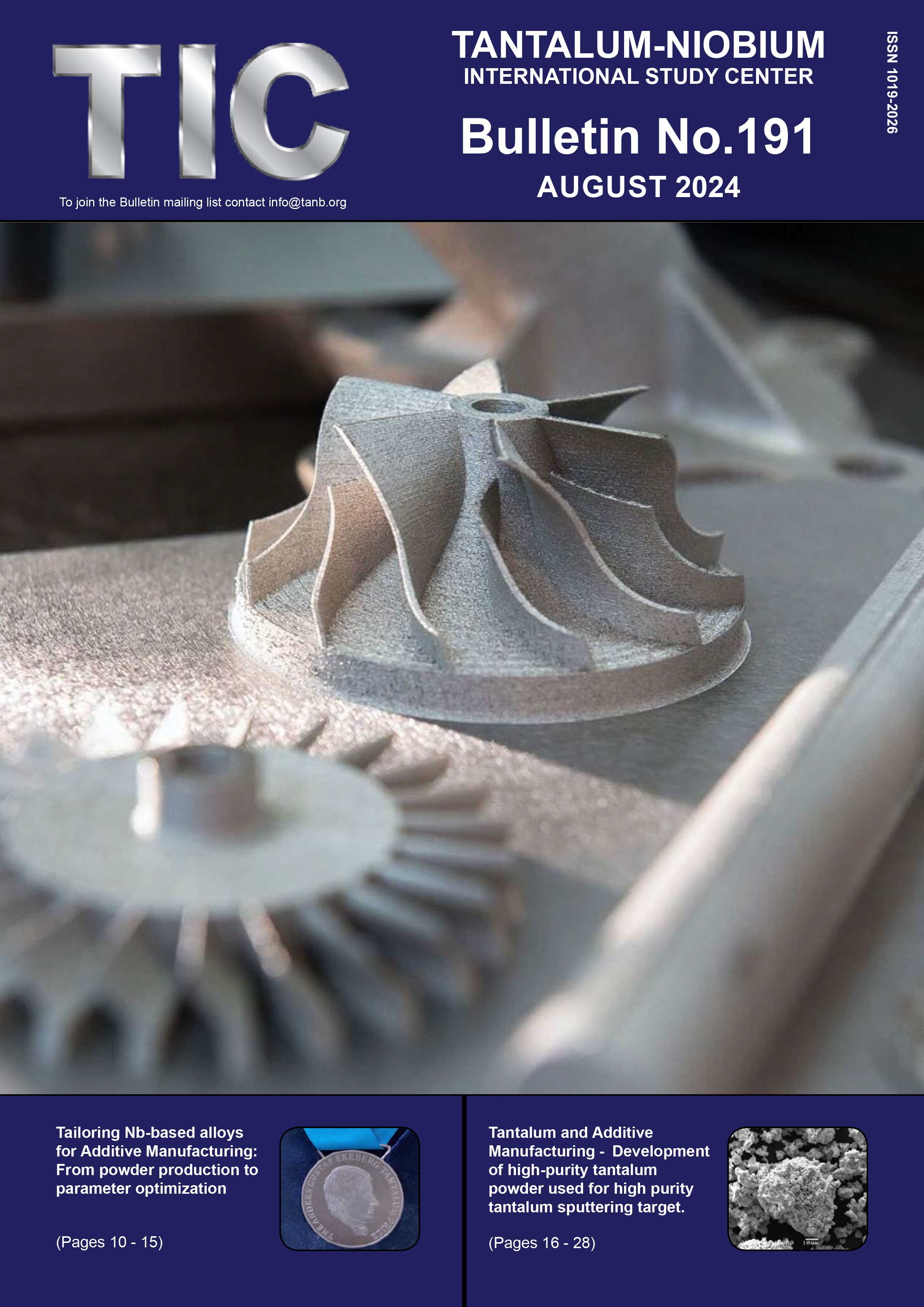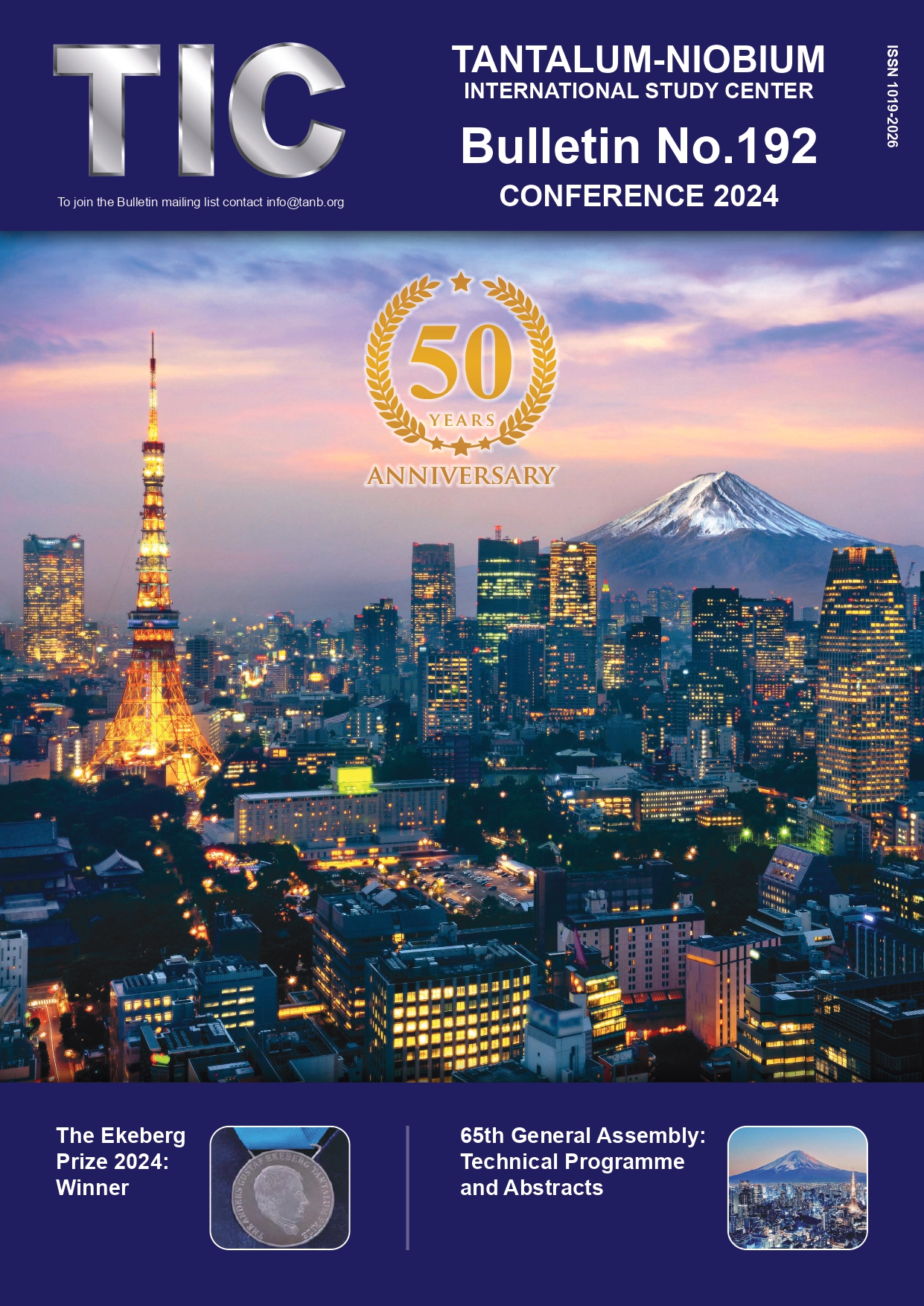Transporting NORM (Naturally Occurring Radioactive Materials)
- - - Pure tantalum (Ta) is not considered to be radioactive by any objective measurement - - -
Niobium and tantalum raw materials can contain low levels of the radioactive elements thorium (Th) and uranium (U), which leads to them being treated as naturally occurring radioactive materials (NORM*).
International transport of NORM is governed by a number of regulations and agreements, which include an exemption level for how much Th and U may be transported without it being of regulatory concern. Materials containing Th and U above this exemption level are transported as "Class 7 Dangerous Goods", which means a number of requirements come into effect that ensure their safe transport. The T.I.C.'s Transport Policy requires all members to fully comply with all applicable international, national and local
regulations governing the safe and secure transport of radioactive materials.
Introduction
The T.I.C.'s guidance document on transporting naturally occurring radioactive materials (NORM) is available here:
 |
 |
 |
 |
|
|
|
|
| English | French | Chinese | Russian | ||||
 |
 |
 |
 |
||||
|
German |
Portuguese | Spanish | Japanese |
Due to the Th and U being locked within the mineral matrix, it is not possible to separate the Th/U easily from these minerals. Only pyrochlore is typically treated near the minesite, with an aluminothermic reduction process removing the Th/U to a waste slag.
For columbite, tantalite, tin slag and other Ta/Nb raw materials, the extraction of the valuable niobium and tantalum content and removal of the Th/U to waste, requires specialised digestion in e.g. hot HF/H2SO4 acid which is conducted by chemical processors located far from the minesites. Transport is therefore required, almost always involving an element of maritime transport, to bring the raw materials from the mines to the processors.
Among some sectors of the public and some authorities there is a negative perception towards any material subject to Class 7 regulation, regardless of the actual nature of the material, its characteristics and its uses to society. The resulting compliance burden of international and/or local regulatory requirements can lead to carriers reaching the sober commercial decision that the transport is more effort than it is worth, resulting in denial of shipment for such Class 7 goods.
Establishing exemption levels
As thorium and uranium are naturally present in the world around us, exemption levels have been set for those materials for whose thorium and uranium content is sufficiently low as to be of no regulatory concern. Materials with thorium and uranium levels below the exemption level may therefore be shipped without needing to comply with Class 7 requirements. These exemption levels are set by the regulatory body the International Atomic Energy Agency (IAEA), based in Vienna, and the levels set for transport are listed in the document SSR-6 (Rev. 1) of 2018 (available here).
The levels for thorium and uranium have not changed since 1996, when isotope specific levels were first introduced. Each radioactive isotope has its own exemption level listed, and natural thorium and uranium each have their entry as “Th (natural)” and “U (natural)” respectively. While natural thorium is present as one isotope, Th-232, it does also have a chain of decay products, a process by which each thorium atom converts to stable (non-radioactive) lead. Natural uranium consists of two isotopes: U-235 being 0.72% of natural uranium by mass, while U-238 forms 99.28%, and each of these forms its own series of radioactive decay chains just like thorium.
| Table 1: Parent and daughter radionuclides for “Th (natural)” and “U (natural)”. | ||
| Th-natural: | Ra-228, Ac-228, Th-228, Ra-224, Rn-220, Po-216, Pb-212, Bi-212, Tl-208 (0.36), Po-212 (0.64) | |
| U-natural: | Th-234, Pa-234m, U-234, Th-230, Ra-226, Rn-222, Po-218, Pb-214, Bi-214, Po-214, Pb-210, Bi-210, Po-210 | |
The IAEA simply lists the parents and their decay chains as “Th (nat)” and “U (nat)”. Note that while U-234 is also naturally present in uranium, it is a daughter of U-238 and is therefore already accounted for in the exemption values; if U-234 was considered separately, it would be counted twice.
The exemption levels for radioactivity concentration are set in units of Becquerels per gram (Bq/g), and these refer to the parent radionuclide only. This is noted in SSR (Rev. 1) of 2018 in Table 2 Footnote (b) (page 45), which states “Parent nuclides and their progeny included in secular equilibrium are listed in the following:” (see Table 1, left).
This interpretation of the footnote in question has been independently confirmed by IAEA representatives and other NORM professionals. There the radioactivity concentration of thorium and uranium can be measured directly (e.g. by gamma spectroscopy) the resulting figures in Bq/g can be compared directly against the exemption levels for Th (natural) and U (natural).
Should only thorium or uranium be present, the comparison is straightforward. If both are present, Para. 405 in SSR (Rev. 1) of 2018 states that a formula should be applied to determine the exemption level for such ‘mixtures’. In practice, given that the exemption level for Th (natural) and U (natural) are the same, the exemption level for that ‘mixture’ is the same as for either the thorium or uranium.
It is not necessary to use the paragraph 405 formula when only dealing with Th and U in secular equilibrium with the decay chains, as noted in the last sentence of para 107 (f). Instead the radioactivity concentration for Th and U is simply combined before comparing against the exemption level, as comparing each result separately for Th and U would effectively double the exemption level. The full exemption level for each radionuclide assumes that there are no other radionuclides present.
Conversion Factors
Where the radioactivity concentration for thorium and uranium can not be measured directly, it is possible to convert chemical assays in % or ppm of Th or ThO2, and U or U3O8, to the radioactivity concentration in Bq/g. The conversion factors are based on the specific activity of the natural radionuclides Th-232 for thorium, and U-235 and U-238 for uranium, only. The specific activities for Th-232, U-235 and U-238 are fixed properties of those radionuclides. The values can be found in various literature or calculated from the half lives, and are:
Th-232: 4055 Bq/g U-235: 80000 Bq/g U-238: 12300 Bq/g
For each radionuclide above, the specific activity is for 100% pure material, therefore the conversion factor for a given percentage is 100 times less.
For thorium the natural ratio ("Th-natural") is:
Th [rad.act.] = 40.6 Bq/g per % Th
Th [rad.act.] = 35.6 Bq/g per % ThO2
For uranium a weighted average is calculated to account for the natural ratio ("U-natural") of U-235 to U-238, i.e. 0.72% and 99.28% respectively. This gives:
U [rad.act.] = 123 Bq/g per % U
U [rad.act.] = 104 Bq/g per % U3O8
These conversion factors were first established by the UK’s National Radiological Protection Board in the late 1990s and have subsequently been checked by the Transport Safety Unit at the IAEA and endorsed as a tool for determining the radioactivity concentration of NORM containing thorium and uranium for the purpose of checking against the exemption values in the transport regulations. Please refer to the Transporting NORM guidance documents (above) for further information.
Summary of the 2007 T.I.C. Risk Assessment
Questions surrounding NORM prompted the T.I.C. in 2003 to question whether the existing exemption level for Th and U is appropriate to the risk posed by the transport of these materials. It prompted a detailed risk assessment of the transport of tantalum raw materials conducted by the external consultants SENES, with the final report being published in 2007, which later became part of a Coordinated Research Programme by the International Atomic Energy Agency on the appropriate regulation of NORM transport, which resulted in the report TECDOC-1728 published in 2010.
Throughout this article the figures quoted in Bq/g refer to the relevant (parent) nuclide only, in accordance with the values listed in the IAEA regulations SSR-6 of 2012. The conversion factors applied are as follows:
- 1% ThO2 = 35.6 Bq/g (1% Th = 40.6 Bq/g)
- 1% U3O8 = 104 Bq/g (1% U = 123 Bq/g)
As part of its commitment to the tantalum and niobium industries the T.I.C. commissioned a detailed investifation into the transport of tantalum raw materials, specifically tantalite and tin slag. The main objectives of this study were to determine the radiological characteristics of these materials and to evaluate the potential radiological exposures associated with normal transport and in the event of an accidental spill. The study was carried out by SENES Consultants Limited (SENES) with support from a number of T.I.C. member companies for the analysis and gamma radiation surveys.
Main conclusions
Radioactive equilibrium in the uranium (U-238) and thorium (Th-232) decay series was found to be a reasonable assumption for tantalum raw materials for dose assessment purposes.
A range of about a factor of 10 in radioactivity concentrations was measured in 67 shipments of tantalite and tin slag, with an average activity concentration (U-238 + Th-232 combined) of about 20 Bq/g for tantalite and about 25 Bq/g for slag. The majority (78%) of tantalite shipments and 45% of slag shipments had concentrations exceeding 10 Bq/g.
Exposure scenarios that considered both duration and location of exposure were established for several types of transport workers and for members of the public. In addition, exposures to facility workers during loading and unloading were assessed in this study to provide perspective on potential exposures from tantalum raw materials. Based on an evaluation of potential exposure pathways, exposure to gamma radiation was determined to be the only significant exposure pathway.
Doses from exposure to spilled materials due to potential accidents were calculated and determined not to be a regulatory concern, as the resulting doses were less than 10 μSv/y.
An assessment of potential dose rates around the transport containers was conducted using the range of measured radioactivity concentrations and modelling of the associated gamma radiation doses using the MicroShield model. The modelling approach overestimated the measured dose rates, primarily due to the assumption that the transport containers always carried full loads whereas in practice the loading pattern varied.
Calculated doses to transport workers and members of the public based on the distribution of measured concentrations are shown in Table 1.
Table 1 - Summary of Doses Calculated for Normal (Non-Accidental) Transport Activities
|
Exposure Scenario |
Mean Dose a, b (mSv/y) |
|
|
Slag |
Tantalite |
|
|
Transport Worker – Truck Driver |
0.24 |
0.16 |
|
Transport Worker – Dockworker |
0.032 |
0.02 |
|
Transport Worker – Seaman |
0.0041 |
0.0026 |
|
Transport Worker – Trainman |
0.019 |
0.012 |
|
Public – Living Adjacent to Road |
0.00038 |
0.00024 |
|
Public – Living Adjacent to Rail |
0.00017 |
0.0001 |
a Mean annual dose from shipments of tantalum raw materials analyzed in this study.
b For perspective, doses to facility workers (who are not considered transport workers) were 0.49 and 0.31 mSv/y from slag and tantalite, respectively.
Doses to members of the public from the transport of these materials were found to be insignificant, that is, much less than 10 μSv/y.
The calculated doses to transport workers were well within the internationally accepted dose limit of 1 mSv/y for non-radiation workers. If it were assumed that the tantalum raw materials considered in this study reliably represent the likely range of tantalum raw materials in general, then the expected (mean) dose to the most exposed group of transport workers would be about 0.24 mSv/y to truck drivers from the transport of slag (Table 1). Thus, there is considerable allowance for truck drivers who transport tantalum raw materials to transport other materials containing elevated levels of naturally occurring radioactivity without exceeding a cumulative annual dose of 1 mSv. On the basis of the analyses of doses arising from the transport of tantalum raw materials described in the report there is no apparent reason with regards to radiological dose for an exemption value as restrictive as the current value of 10 Bq/g for these materials. Even in the absence of an exemption value, as shown in Table 1 no one would be expected to receive a dose above 1 mSv/y arising from the transport of tantalum raw materials.
Notwithstanding the low doses from the transport of tantalum raw materials, specific numerical exemption values are required for the practical, real-world application of the transport regulations. Moreover, the radioactivity levels of future shipments of tantalum raw materials may differ from the distribution of levels from which the conclusions of this study were derived. If it were conservatively assumed that the radioactivity levels of all future exempted shipments of tantalum raw materials were at a selected specific exemption value, the resultant annual doses due to exempted shipments under actual transport situations would be overestimated. The calculated doses to transport workers under this assumption are summarized in Table 2 for various potential exemption values.
Table 2 - Summary of Annual Doses (mSv/y) to Transport Workers at Various Potential Exemption Values
| Potential Exemption Value (Bq/g) | Material | Annual Dose (mSv/y) a | |||
| Truck Driver | Dock Worker | Seaman | Trainman | ||
| 10 | Tantalite | 0.12 | 0.016 | 0.0021 | 0.0097 |
| Slag | 0.12 | 0.016 | 0.0021 | 0.0098 | |
| 30 | Tantalite | 0.31 | 0.040 | 0.0052 | 0.024 |
| Slag | 0.37 | 0.049 | 0.0062 | 0.029 | |
| 50 | Tantalite | 0.48 | 0.062 | 0.0080 | 0.038 |
| Slag | 0.54 | 0.071 | 0.0091 | 0.043 | |
| 70 | Tantalite | 0.65 | 0.084 | 0.011 | 0.051 |
| Slag | 0.71 | 0.093 | 0.012 | 0.056 | |
| 90 | Tantalite | 0.82 | 0.11 | 0.014 | 0.064 |
| Slag | 0.89 | 0.12 | 0.015 | 0.070 | |
| 100 | Tantalite | 0.91 | 0.12 | 0.015 | 0.071 |
| Slag | 0.97 | 0.13 | 0.016 | 0.077 | |
a - assume 1.5 tiers of material






